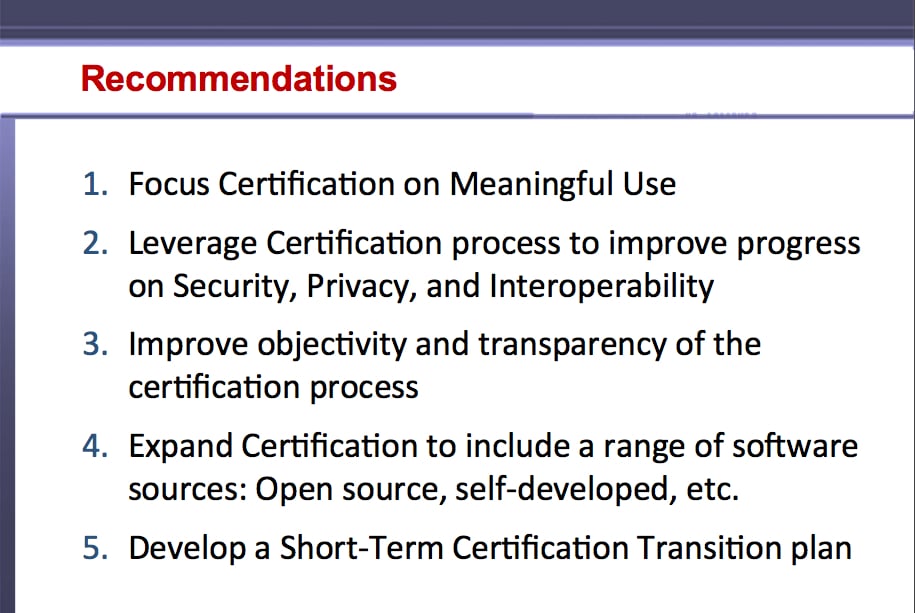Today, the HIT Policy Committee met once again, this time to hammer out what the term “certified EHR” means within the context of future ARRA reimbursements to physicians and hospitals. Chilmark sat in on the discussions, here is our assessment of what transpired. (See yesterday’s post, below, as to why the Certification issue is critical.)
The Certification workgroup presented their refined recommendations today (these were first announced at the July 16th meeting), which were subsequently approved by the broader HIT Policy Committee. Marc Probst of InterMountain Healthcare and co-chair of the workgroup led discussions which began with a high level list of five recommendations, (see slide below). For simplicity, we will focus on these five recommendations in our discussions as they encapsulate the entire meeting and what was ultimately approved.
In Recommendation 1 the workgroup emphasized that certification criteria must be kept at a high level, (e.g., not specify how an alert would be presented, simply that one would be presented) criteria must directly link back to supporting the meaningful use criteria that were approved on July 16th. Th workgroup also emphasized that the creation of certification criteria must be the responsibility of HHS/ONC and not a third party such as CCHIT. (Note: CMS is now converting MU criteria into actual rules – and based on some comments today, it is not an easy task. Creating certification criteria will be easier, but still a lot to add on to the plate of HHS who already has its hands full.)
But where the workgroup wants a lot of specificity is with interoperability suggesting that HHS/CMS develop certification criteria that is quite specific to insure interoperability between systems. With such tight time-frames and deadlines in place, this issue of interoperability could become one of the most challenging aspects of the whole HITECH Act, for underlying all three workgroups (Meaningful Use, Certification and HIEs) is interoperability. But what is interoperability anyway? Is it computable data? Is it transmittal and sharing of PDFs? Is it order sets, med lists, labs?
Looking back, the Meaningful Use matrix does provide some guidance as to what data is to be shared for care coordination, but that still does not eliminate the challenge of creating specific criteria for interoperability that can be readily certified and put into the market. Also, it is important to note that certification for vendors may have to occur every two years (2011, 2013, 2015) in lock-step with the ever increasing requirements for meaningful use which itself calls for ever more complex data sets to be shared.
Recommendation 2 was pretty much a no brainer as ARRA legislation specifically calls for certain enhancements to security and privacy of medical records (audit trails, consent, etc.). Here again the workgroup emphasized the need for HHS to get aggressive on establishing clear certification guidance on interoperability as it pertains to addressing security and privacy.
It was in Recommendation 3 that the workgroup suggested that HHS allow multiple certification organizations (not just CCHIT), to conduct certifications of EHR systems stating that this will help create a competitive market for such services and increase transparency into the certification process. The workgroup also recommended that NIST establish and execute an accreditation process for certifying organizations.
While CCHIT has certainly been marginalized, they will still play an important role in the interim. Right now there are no other certifying organizations, the market is being quite cautious in making any large EMR purchases awaiting to see what comes out of DC and this whole certification/accreditation development and meaningful use rule-making is going to take time. What was proposed today is that CCHIT take the lead until at least October (it will more likely end up being well into Q1’10) for mapping meaningful use criteria, as defined in the matrix, to high level certification criteria and provide an interim certification for EHR systems. Remember, this role of CCHIT is on an interim basis and NOT permanent, though others may want you to think differently (Note, Government Health IT is owned by HIMSS a strong advocate of CCHIT.)
The workgroup also wanted to acknowledge the investments that HIT vendors have already made to get CCHIT certified. Thus, for those vendors with 2008 CCHIT certification, they need not go through a whole re-certification once guidelines are released, but simply be certified for any gaps that may exist between these two certification processes, with the latter focused on meaningful use.
For Recommendation 4 it appears that like CCHIT, the workgroup received a lot of feedback from Open Source advocates, those that developed their own solutions and smaller software companies that have developed EHR enabling modules. Therefore, the workgroup followed CCHIT’s lead wih a similar strategy recommending that all systems be tested equally with same high level criteria, regardless of the source of the software. They also encouraged a “flexible certification process” that will account for non-traditional software sources (eg, the RYO camp) and that there be a process to certify distinct, meaningful use enabling modules (eg, eRx). Chilmark thought CCHIT did a good job here and it is equally good to see the workgroup recommend the same.
Recommendation 5 ties back into what we discussed earlier with regards to the future role of CCHIT – there needs to be a transition phase to account for the time-lag between the need to begin certifying EHRs for market and the lengthy rule-making process for meaningful use. The workgroup recommends adopting what certification criteria that exists today (obviously from CCHIT) that supports meaningful use and where there are no existing criteria, work to converge criteria to meaningful use rules through close internal collaborations within HHS.
This is where it is going to get a little tricky as both the meaningful use matirx is a bit vague and well certification criteria, that is even more vague. How do we bring convergence for all this in a timely fashion so that physicians and hospitals can begin installing certified EHRs that provide them the capability to demonstrate meaningful use in order to get their 2011 reimbursement? We’re not sure how to get there from here, but one thing is for sure, it will be a rocky road ahead.





Thank you for the analysis of the meeting. I have posted the rough draft transcript and meeting materials here:
http://ahier.blogspot.com/2009/08/rough-draft-transcript-hit-policy-mtg.html
CCHIT has been approved (alone for now) and I expect we will begin to have certified products by Thanksgiving, but I hope that we will see some opening for smaller vendors and open source.
I think the statement “CCHIT has been marginalized” is a gross overstatement of what actually occurred today. CCHIT is the only game in town at the moment. They have been at it for a number of years now, how long does anyone think it will take for a new player to make an entrance, six months, one year?
I seriously doubt any organization will enter the “fray” in less than a year. Apparently there is now an accreditation board that needs to be established, and in any case an organization that wants to play needs ramp-up time. After the ramp up time they need to get the accreditation board’s seal of approval.
So yes there will be competition. That is a good thing, but not the same as indicating CCHIT has been marginalized. CCHIT will remain a strong and influential player for the foreseeable future. Those are the facts as they exist on the ground.
Who’s to say that CCHIT will not be one of the permanent players, despite the fact that HHS will define the criteria for “meaningful use” and “certified EHR?” I think it is way too early to predict CCHIT’s demise.
I think the biggest message from this meeting is that we’re a long way from really knowing what’s going to be required to get the EMR stimulus money. Certainly they’re trying to speed up the process with “provisional” certification and things like that, but we’re looking at early January before I think we’ll really know what “certified EHR” will really mean. They still have to define all the meaningful use before the finalize stuff.
Plus, I think they’re really missing a lot of the detail in certifying software versus organizations. Not to mention how they’re actually going to do this reliably. There are so many problems and things they haven’t discussed that you’re right in saying we’re going to have a rocky road.
What is true is that CCHIT has gotten their foot back in the door more than last meeting. I guess the lobbying bodies have been hard at work.
I’m calling for this whole thing to be a pretty epic failure. They’ve made it so complicated and painful that it’s going to leave a mess in its wake.
In any other endeavor, the HHS would not support such a potential ‘conflict-of-interest’, as CCHIT represents with HIMSS. It may be part of a larger picture, but to suggest that it is the only certification entity at this point in time is not factual – we are still in a time of transition. One of the differences between the U.S. DOD and Federal Health Agencies like HHS and the NIH is that the latter have always been very concerned about even the perception of conflict. I hope we can stay open-minded and not let the lobbyists decide the outcome.